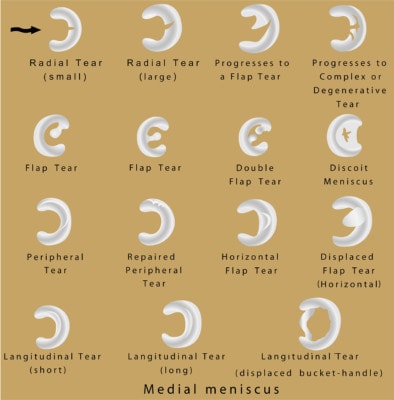Can You Treat a Meniscus Tear Without Surgery?
The research support on using surgery to treat meniscus tears is collapsing. Study after study shows that this common surgery doesn’t work and likely sets patients up for more problems down the road. However, there’s one type of meniscus tear that has been thought to always require surgery – a flipped bucket handle tear. This type of tear is when the meniscus pulls apart and one piece flips over, usually causing locking of the joint. Can you treat a flipped bucket handle meniscus tear without surgery? This is one patient’s experience of skipping the surgery for an injection of her own stem cells.

Lotan/Shutterstock
For some background, The meniscus is a shock absorbing spacer that sits between the two cartilage surfaces of the knee. Meniscus tears are common; in fact they’re so common in middle age that one recent author has said that they’re as common as wrinkles in old age (and about as important). The particularly difficult flipped bucket handle tear, however, is definitely more than a wrinkle and does require treatment.
DM was a patient who I first examined in April of last year. She was having knee locking and her MRI had shown a flipped bucket handle tear. She also had a chronic issue with her low back, that likely led to her knee problems. I treated the knee with precise injections of bone marrow concentrate containing her stem cells into her meniscus tear using our Regenexx-SD procedure and treated her low back with the Regenexx-PL-Disc procedure. This is what she wrote to me last week:
“Hello Dr. Centeno,
Hope you doing well. Next month will be my one year anniversary from when you worked on me knee. The meniscus had been torn quite severely as the result of playing hockey with my kids. I am happy to report that with your help and lots of prayer I am 99% healed. Thank you so much for helping me…
DM”
The upshot? This is a woman who would have gotten the flipped portion of her meniscus cut out, leaving her with less spacer and a higher risk for arthritis. Instead, she was treated without any surgery with much less downtime using a precise injection of her own stem cells under ultrasound guidance.

If you have questions or comments about this blog post, please email us at [email protected]
NOTE: This blog post provides general information to help the reader better understand regenerative medicine, musculoskeletal health, and related subjects. All content provided in this blog, website, or any linked materials, including text, graphics, images, patient profiles, outcomes, and information, are not intended and should not be considered or used as a substitute for medical advice, diagnosis, or treatment. Please always consult with a professional and certified healthcare provider to discuss if a treatment is right for you.
